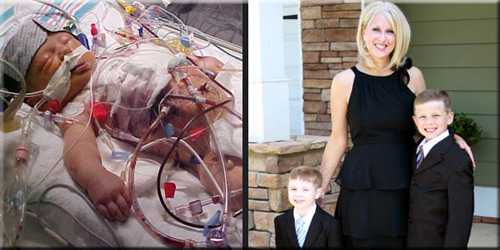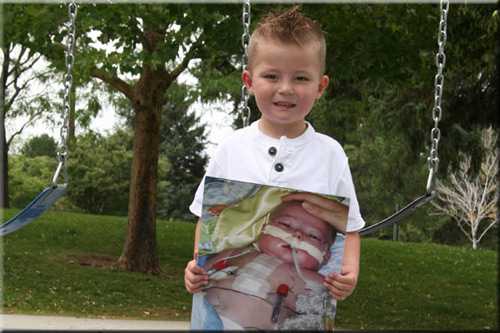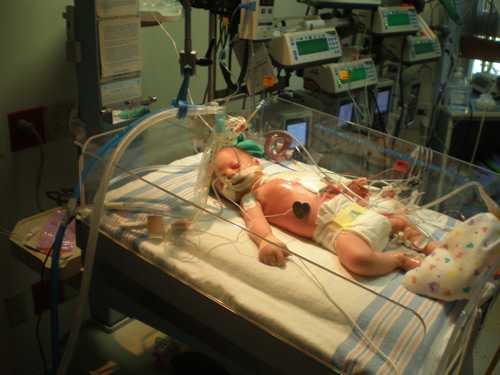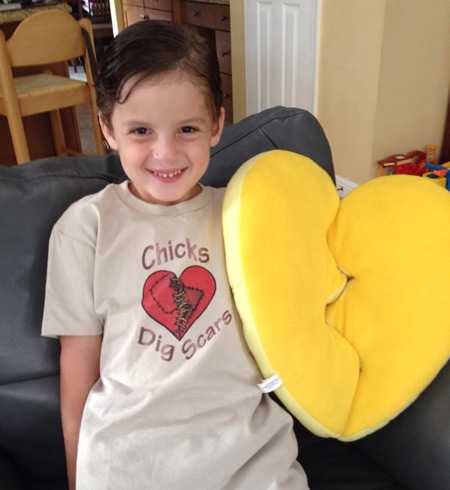Stories: Living with Hypoplastic Left Heart Syndrome
Hypoplastic left heart syndrome (HLHS) is a birth defect that affects normal blood flow through the heart. As the baby develops during pregnancy, the left side of the heart does not form correctly. To learn what it’s like to live with this condition or how families are affected, read these real stories from people living with hypoplastic left heart syndrome.

Nick’s Story
Nick was born with a congenital heart defect (CHD) that required multiple surgeries and eventually a heart transplant. His mother shares her perspective on what it felt like to leave the hospital without her newborn son, the challenges he has faced growing up, and the need for more research to better understand the causes of CHDs. Read more below.
As Susan welcomed the birth of her son Nick, she thought everything seemed normal. However, as she asked, “Is my baby fine?” the initial smiles surrounding her quickly changed to whispers and concerned looks. Soon, Nick was whisked away to specialists in a large children’s hospital while Susan was left behind. Shortly afterward, she was released, leaving with a balloon that read “It’s a boy!” but she held no baby boy in her arms. Susan did not realize then that the adventure had only begun as tests soon revealed that her baby had a congenital heart defect.
After Nick had three difficult open heart surgeries, his doctors decided that he could survive only with a heart transplant. Just before his second birthday, Nick received his new heart. Although Nick is an adult now and doing well, he and his parents still worry about transplant rejection and the future. “I think about the pain and frustration we have been through, and my hope for other families is that we can find out what causes congenital heart defects so that we can prevent them,” added Susan.

Ryan’s Story – Written by his mom Laura
Laura shares the story of her son, Ryan, who was born with a critical congenital heart defect (critical CHD). Ryan’s CCHD went undetected for the first 24 hours of his life, but fortunately was discovered in time for immediate treatment. Although Ryan had a rough start, he has grown into a happy, thriving boy. Read his story below.
The night after my son, Ryan, was born, I felt like something wasn’t right. He did not cry. He had a hard time feeding. He felt cold. When the pediatrician found nothing wrong and cleared him to go home, I had an uneasy feeling. But it wasn’t until that first night home, when his legs were bluish in color and his breathing was labored, that we knew for sure that something was wrong. We called the paramedics, and when we got to the hospital, the doctors recognized that something was wrong with his heart. After some more testing, the doctor came in and very bluntly told us that our beautiful son had a very grave heart condition called hypoplastic left heart syndrome. Without immediate intervention, he would die. Suddenly, the room was swirling, and I crumpled to the floor. All I could think about was how our older son might not see his little brother again.
Since that day, Ryan has had a number of surgeries, his first one at only five days old. He slowly got better, but at two years old, he took a turn for the worse, and we decided to put him on the heart transplant list. While Ryan was in the intensive care unit (ICU) getting more and more sick, we finally heard the doctor say those magic words, “We have a potential heart.” On the day of his transplant, my husband happened to get in the elevator with the man transporting the heart. All he could muster to say was “Take care of my son’s heart.”
Ryan has grown up and is doing awesome. He is such a blessing to our family—we cherish every day with him. It hasn’t been easy. There have been many challenges, like getting insurance to help with all the bills and getting Ryan the support he needs to reach his milestones. But I would not change a thing. I want the world for him. I want him to be able to do whatever he wants. And, he does. He wakes up every day, the happiest kid with no fear.

Teagan’s Story– Written by his mom, Brytten
Teagan was born with a critical congenital heart defect (CCHD). His mom shares her experience of how during the first year of life she focused on keeping Teagan alive. Read his inspiring story below.
In March of 2008, I gave birth to my second son, a big, beautiful, healthy baby boy, Teagan. Four days later, I found out that my big, beautiful, healthy baby boy was not so healthy. Teagan was diagnosed with a congenital heart defect (CHD)—hypoplastic left heart syndrome (HLHS)—basically, half a heart. My life as I knew it was over and my life as a Heart Mom began.
It is not the life I dreamed of while he grew in my belly for nine months, but it is my life nonetheless. Teagan’s first year was the hardest year of my life to date. He had his first of three planned open heart surgeries at seven days of age. We stayed at the hospital for eight weeks. When I finally brought him home again he was very fragile, on several medications, needed shots twice a day, was on oxygen, and had a feeding tube. We were home for a few months and by the end of July 2008, he was in desperate need of his second planned open heart surgery and some other procedures. We had a six week hospital stay this time and returned home shortly after his five month birthday. Our days were full of medications and tube feeds, oxygen saturation checks, lots of doctors, home health care specialists, and Early Intervention. We had to do all we could to stay healthy, so we had to miss out on a lot of family functions and stayed home a lot. Slowly but surely, I got used to my new normal and life as a Heart Mom.
Today Teagan likes to tell people, “My heart is happy and strong!” He goes to preschool, loves to play with (healthy) friends, wrestle with his big brother, play super heroes, watch his shows, sing the current hits, swim, go on family vacations and ride his scooter. We are currently waiting for his heart to need a third planned open heart surgery, and we anticipate an eventual need of a full heart transplant. Teagan is currently on three medications a day. He is fed through his g-tube twice a day and the rest of his food he eats by mouth. We still try really hard to not get sick and we are extra aware of the germs around us. Teagan’s first year of life was about keeping him alive, and now it’s about letting him live! I feel so blessed to be the mother of such an incredible boy, he is truly a miracle! My life is richer than I ever could have dreamed of since the day I became a Heart Mom!

Caden’s Story-Written by his mom, Dawn
A birth defect diagnosis during pregnancy can challenge any family. Dawn’s son, Caden, was diagnosed with a heart defect during her pregnancy. Read below to see how she approached her pregnancy after the diagnosis and her advice for other parents.
My son, Caden, was born with hypoplastic left heart syndrome, a type of congenital heart defect (CHD). After two previous normal pregnancies, I was shocked to receive this diagnosis during my 20th week of pregnancy with Caden. I have to admit, receiving the diagnosis during pregnancy was both a blessing and a curse. It robbed me of any sort of normal pregnancy. After the diagnosis, we grieved a lot. Everything we had in our minds about this pregnancy went away. We had to prepare for a whole new pregnancy. Everything became about the baby. We had so many ultrasounds and tests to check the baby’s heart.
That said, the diagnosis helped me prepare for what we needed to do. We researched what the defect was and what the prognosis would be. We tried to get all the best doctors on our case right from the beginning. We were also able to prepare our other children—we had to tell them that their sibling would not be coming home from the hospital right away. Our older son understood the seriousness of what my husband and I were saying, but my younger daughter didn’t quite get it. She just knew the baby was sick.
After the diagnosis, we chose not find out the sex of the baby. We were worried that with more information about the baby, we would start bonding. We thought it might be more difficult for our children if anything happened to Caden. More than that though, I wanted one moment that was a normal pregnancy. No matter what happened, the one thing that they couldn’t take away from me was the moment where they lifted the baby over the curtain and said “It’s a boy!” I wanted that moment to be about our family, about Caden, and not about the CHD.
I remember the first time my other children saw Caden after he was born. When my older son came into the room, he didn’t see any tubes. He didn’t see any bandages. He just saw his little brother. It was such a sweet moment. I think it was a Top 5 moment in my life.

Caden has had to undergo three open-heart surgeries since birth and spent a lot of time in the hospital, but he is doing really well now. He loves soccer, has traveled to six countries, and he’s a crazy, rowdy child who tested gifted in school. In the end, I wanted to share Caden’s story to help give other CHD parents hope. It’s a scary diagnosis, but so much of your baby’s success is your own attitude and how you approach the challenges. I remember when I was pregnant, I only saw one positive success story—one article where the baby was clapping and looked happy and healthy. It was a story about survival. I clipped it out, and it still resides in Caden’s baby book. Don’t lose sight of that hope.
I also wanted to share his story to help raise awareness of CHD. Caden may look normal and play soccer like any other child. But, at any point, the other shoe could drop. Regardless of what he looks like on the outside, he only has half a heart working for him on the inside. And that’s why research is so important. If not for the research that’s been done, Caden wouldn’t even have a story. He wouldn’t be here with us today.
Caden has taught us lessons that we might never have learned otherwise. He taught us a different way of looking at the world. He’s a picture of inspiration for many people. Most importantly, he is a thriving little boy – one who is not defined by his heart diagnosis.
- Page last reviewed: May 15, 2017
- Page last updated: May 15, 2017
- Content source:



 ShareCompartir
ShareCompartir